Rockhounding Arizona by Gerry Blair

Author:Gerry Blair
Language: eng
Format: epub
ISBN: 9781461745877
Publisher: Falcon Guides
Foy Partain of Farmington, New Mexico, incorporates sandstone patterns into his paintings.
Some lapidaries have discovered a hobby application for flagstone. Thin slabs are pleasingly shaped to serve as backgrounds for pictographic drawings. Metal and gemstone cutouts are attached to the flagstone using epoxy or a hot-glue gun. The resulting color and textural contrast can be handsome.
The low hills to the north of the town of Ash Fork hold a plentitude of active and inactive flagstone quarries. Small slabs, too small for commercial use, abound. Many are the right size for rockhound applications. As you collect, stay alert for slabs that show evidence of fossil inclusions and watch for slabs that have been stained by mineral inclusion. Such âscenic sandstoneâ can be particularly effective as the background for a painting.
To reach the quarries, take Forest Road 142 north from Ash Fork. Drive 2 miles to the junction of Forest Road 39 and turn right. About 4 miles later you will see a cluster of quarries in the area of Antolini Hill.
A 10-square-mile area is pocked with the quarries. Stop at the Kaibab National Forest Ranger Station in the town of Williams to purchase a Kaibab forest map. You will find it immensely helpful, as the mines are marked with the crossed-pick symbol. Many, maybe even most, of the forest roads are somewhat primitive and are only occasionally maintained. Many are too primitive for a passenger car. Pickups are better; pickups equipped with four-wheel drive are best.
Some rockhounds do not saw the flagstone. It has natural cleavage planes that permit separation along the bedding plane. Pliers are then used to ânibbleâ the piece to shape.
If you must use the saw, do not use oil as the lubricant. Oil will permeate the sandstone and is apt to create a messy cleanup chore. After draining the oil, use warm soapy water to scrub away the residual oil, and use a new batch of warm soapy water as a lubricant. If possible, saw other soft or porous material using the water as a coolant. Drain out the water when the job is done, and return the oil. Leaving the water in the tank will almost surely cause the blade to rust.
Download
This site does not store any files on its server. We only index and link to content provided by other sites. Please contact the content providers to delete copyright contents if any and email us, we'll remove relevant links or contents immediately.
| General | Grand Canyon |
| Phoenix | Tucson |
Giovanni's Room by James Baldwin(5937)
The Plant Paradox by Dr. Steven R. Gundry M.D(2060)
The Stranger in the Woods by Michael Finkel(1939)
Miami by Joan Didion(1888)
DK Eyewitness Top 10 Travel Guides Orlando by DK(1826)
Vacationland by John Hodgman(1784)
Trail Magic by Trevelyan Quest Edwards & Hazel Edwards(1771)
Wild: From Lost to Found on the Pacific Crest Trail by Cheryl Strayed(1757)
INTO THE WILD by Jon Krakauer(1741)
The Twilight Saga Collection by Stephenie Meyer(1734)
Nomadland by Jessica Bruder(1698)
Birds of the Pacific Northwest by Shewey John; Blount Tim;(1614)
Portland: Including the Coast, Mounts Hood and St. Helens, and the Santiam River by Paul Gerald(1588)
The Last Flight by Julie Clark(1513)
On Trails by Robert Moor(1490)
Deep South by Paul Theroux(1485)
Trees and Shrubs of the Pacific Northwest by Mark Turner(1436)
Blue Highways by William Least Heat-Moon(1389)
1,000 Places to See in the United States and Canada Before You Die (1,000 Places to See in the United States & Canada Before You) by Patricia Schultz(1306)
